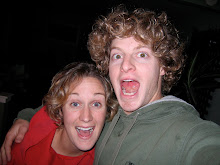Sorry for the lack of recent posts but our adventure has actually been extremely unexciting lately. I know many people believe that we're on a constantly eventful wild whirlwind of a trip but that couldn't be further from the truth. There are many days that could simply be documented as, “wake up, eat, pack everything onto our bikes, ride, eat, ride, eat, ride, set up camp, eat, sleep.” Though it's not quite an ordinary life, it can certainly be monotonous at times, and it's been one of those times.
Once we left Granada, we rode north through the heart of Spain. The countryside was peaceful and beautiful with pleasantly rolling hills which allowed us to put in several days of long miles and although it felt great, there was nothing extremely noteworthy to report.
Between Granada and the Pyrenees
A house built into a rock cliff
Cari and a Roman bridge
We arrived to the Pyrenees about a week ago only to find that these famed mountains were enveloped in low-hanging, gray rainclouds. We know they're there; we can sometimes see the dark outlines of the mountains reaching up towards the heavens behind the thin, lingering clouds. If only they'd lift during the day rather than giving us clear, starry nights we'd be happy campers. I guess it was our turn to be stuck in the cold and rain. We completely lucked out along the Carretera Austral in Chile where we had the most perfect weather anyone could wish for while most people cycling that route are cold and wet for nearly the entire time. You can't win them all.
Cloudy day in the Pyrenees
Mike and Cari
Ainsa, Spain
We got a glimpse of the mountains for a couple of hours one morning. Then it rained for the rest of the day.
Taking advantage of a little sunshine. We had a lot of wet clothes from the day before that needed to dry.
It's been a bummer of a week in a sense that we've put in monstrous amounts of effort to lug ourselves up one steep mountain road after another only to get nothing for a view in return, but I have to say that these roads have been absolutely thrilling. Occasionally we have a section of road that is wide and sweeping and although they don't provide us with the grand vistas they're capable of, they do offer an exhilarating, though frigid, descent in which we're cruising at unquestionably dangerous speeds but don't want to grasp the brakes to ruin the happily squealing voices inside our heads. However, more often than not, we find ourselves on extremely narrow roads that switch-back their way up and down the steep sides of the mountains. We can look over the sides of the infrequently present guard rails down into the valleys below and seeing the sheer drop-off over the edge is enough to keep us from descending at anything more than a snail's pace.
Mountain road
Snaking mountain roads
We could easily have been through the entire mountain range by now if we were pushing ourselves, but it would be such a shame to completely traverse them without ever actually seeing them. We've been watching the weather and although mountain weather can change in a nanosecond, the forecast has been telling us that we're going to get 2 days of decent, or at least rainless, weather on Tuesday and Wednesday. So today we're waiting. We're not really in need of a rest day, but we've found a campground that is comfortable and conveniently located and don't want to waste yet another day of potentially spectacular riding. We often have to remind ourselves that we're in no rush, have nowhere that we actually have to be and should therefore put aside our antsy-ness, take our time and wait out the bad weather in order to see the things we so enthusiastically want to see.


































